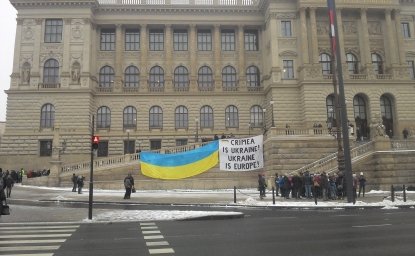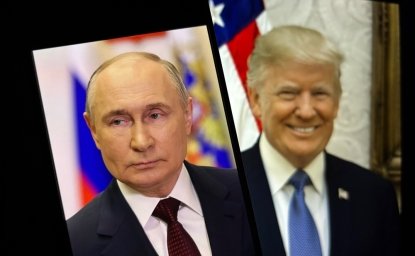The Ghost of Freedom: Writing a History of the Caucasus

"The Caucasus has an air of the alien, the foreign, in the Western imagination, which we in the West have inherited perhaps from the Russian imagination," stated Charles King, Ion Ratiu Professor of Romanian Studies, professor of international affairs, professor of government, and faculty chair, Edmund A. Walsh School of Foreign Service, Georgetown University, and former Title VIII-Supported Short-Term Scholar, Kennan Institute. Speaking at a 26 February 2008 Kennan Institute lecture, King said his new book The Ghost of Freedom: A History of the Caucasus is an attempt to tell the story of the Caucasus in a way that moves beyond cultural stereotypes that characterize the region as violent, exotic, and impossibly diverse. According to King, his research is "an attempt to rescue the Caucasus from its own foreignness."
For all of its strategic importance, the Caucasus remains relatively unknown in the United States, and in the West, in general. However, this was not always the case, King pointed out. He said he sought to help remind readers that thinking of the Caucasus as alien or foreign is a rather modern way of looking at the region. "If we go back in the 19th century, in the history of America's engagement with the world, or Britain's engagement with the world, we knew far more about this part of the world than we do today," King said. He cited several recurring characters in the American popular imagination of the 19th century, including the "Circassian beauty," who would have been an exotically beautiful performer at circuses or shows, and the "Cossack," who would have performed tricks on horseback. The name "Circassia" would have meant something tangible to an American of this time. Part of the book, King stated, is to explore this earlier familiarity with the Caucasus.
King said he was also trying to complicate the imperial Russian history of the Caucasus. In this version of history, he said, the major story line is the incremental absorption of the Caucasus into the Russian Empire. King pointed out that he wanted to explore the role played by other powers, including the Ottoman and Persian Empires. Also missing from imperial narratives were indigenous perspectives, and King said he sought to include them where possible.
In both Russian and Western historiography, the military element has been stressed, and the conflict was romanticized on all sides as either a tale of glorious conquest or valorous resistance, King pointed out. For example, Scottish nobleman David Urquhart traveled to the Caucasus in the 19th century, and is largely responsible for the Western sense of a valorous and noble resistance to Russian rule on the part of Caucasian highlanders, King asserted. During his time in the Caucasus, Urquhart designed the flag currently used by Circassians, and generally conceived of the various ethnic groups as "proto-nations," which influenced the region and the Western imagination. Further, while it is commonly taken for granted that the Caucasus mountain range divides the North Caucasus from the South Caucasus, King asserted that the more historically important division has been along the west-east axis, with the Caucasus mountains functioning as a connector, rather than as a divider.
King also focused on the importance of the Soviet period in the history of the Caucasus. He argued that the Soviet experience took vague and ambiguous national identities and consolidated them into a coherent Soviet sense of what a nation should be. The Soviet Union's focus on national identity eventually made this awareness the primary identity in the region, placing it above religious or clan identity. It also provided many peoples of the region with the core historical tragedies around which nationalists could organize a sense of nationhood, including the deportations and other repressions. During the late Soviet period, King observed that the historical process began to move toward reclaiming the ethno-demographic territory as the various people defined it. This process was conceptualized as undoing the demographic engineering of the Soviet Union, but more importantly the Russian Empire before that.
Finally, King traced the idea of the Caucasus as part of European history. The Caucasus has been seen as a part of Europe by many thinkers, especially in the 19th century, he asserted. Today the idea of the Caucasus as a part of Europe has a powerful resonance, especially in Georgia. For example, Georgian President Mikheil Saakashvili ordered the flag of the Council of Europe to be flown outside of government buildings alongside the Georgian flag.
King acknowledged that the Soviet policy of creating ethno-territorial units often functioned as sources of mobilization for national activists, although he cautioned that not all ethno-territorial units in the North Caucasus exploded into violence. For this reason, he said that violence during and after the collapse of the Soviet Union was not exclusively a result of ethnic hatreds, but rather of a deliberate policy choice on the part of both Russian and Caucasian elites to avoid a peaceful resolution of the conflict.
Author

Kennan Institute
After more than 50 years as a vital part of the Wilson Center legacy, the Kennan Institute has become an independent think tank. You can find the current website for the Kennan Institute at kennaninstitute.org. Please look for future announcements about partnership activities between the Wilson Center and the Kennan Institute at Wilson Center Press Room. The Kennan Institute is the premier US center for advanced research on Eurasia and the oldest and largest regional program at the Woodrow Wilson International Center for Scholars. The Kennan Institute is committed to improving American understanding of Russia, Ukraine, Central Asia, the South Caucasus, and the surrounding region through research and exchange. Read more

Explore More
Browse Insights & Analysis
The OSCE is a Good Value for America

Infographic | Russia's Illegal Annexation of Crimea

Russia’s Indigenous Communities and the War in Ukraine
